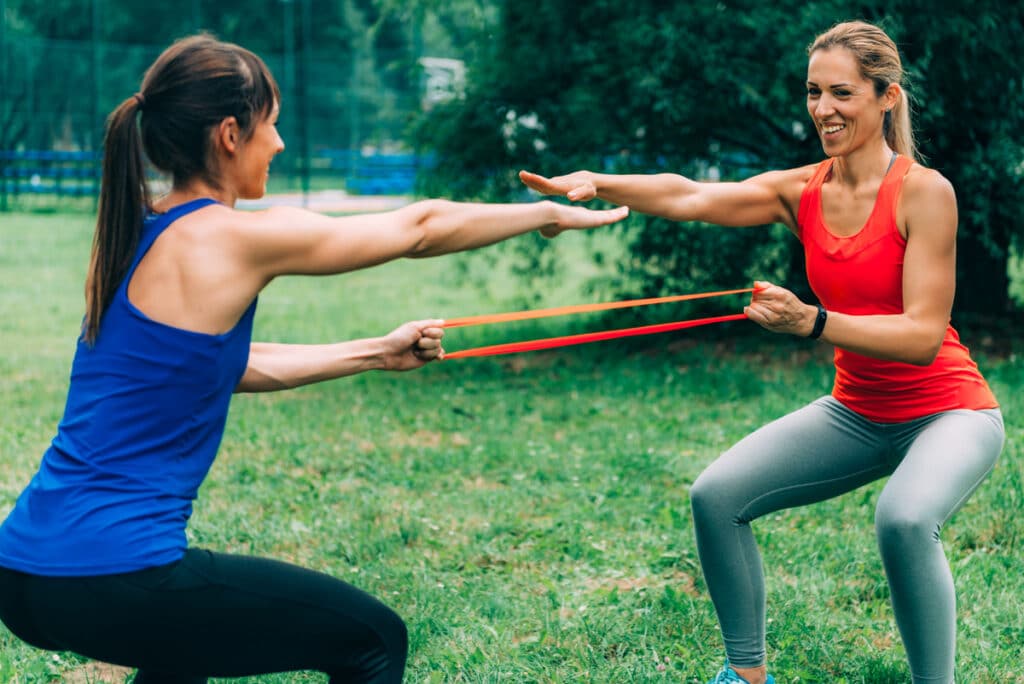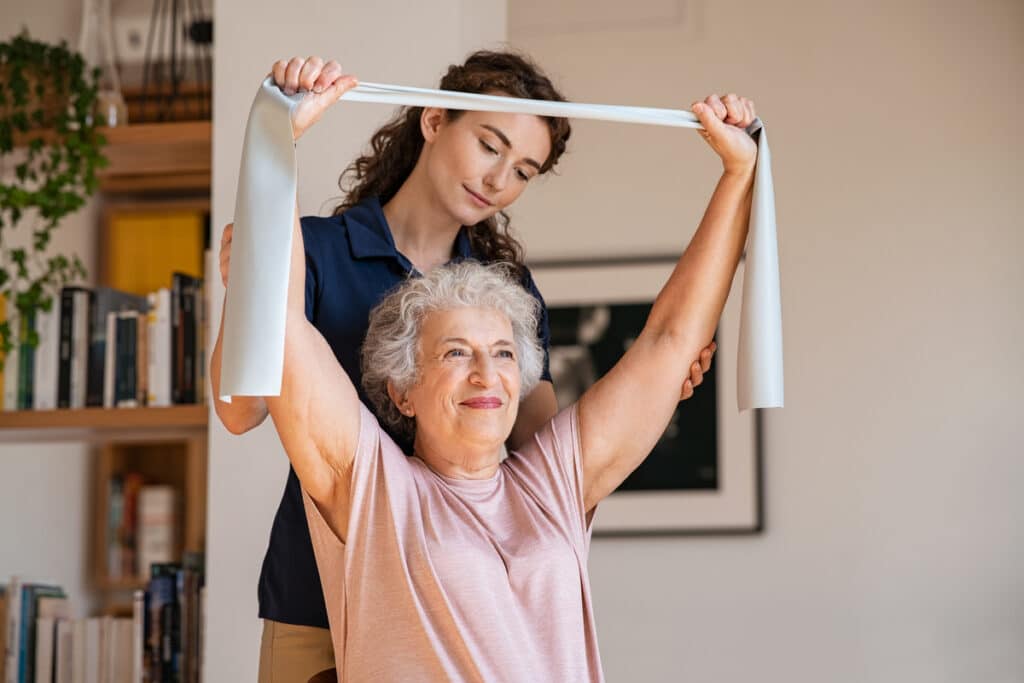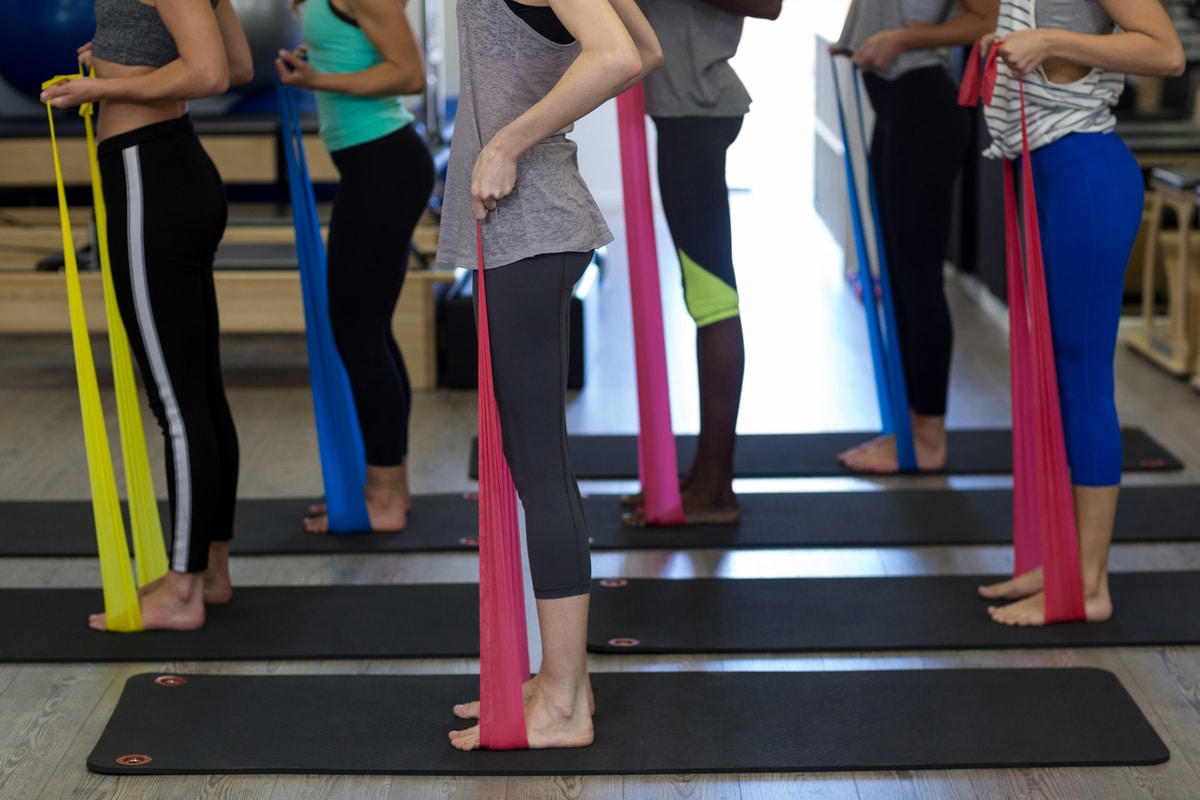Therapy bands are commonly used in physical therapy to help patients improve their range of motion and flexibility. The resistance of the band helps strengthen muscles and improve joint stability. You can use therapy bands for various exercises, including stretching, strengthening, balance, and coordination. Therapy bands are an effective and safe way to help patients regain strength and mobility after an injury or surgery.
Therapy bands come in various resistance levels, so choosing the right one for your fitness level is essential. If you are new to using therapy bands, start with lighter resistance and gradually increase the level as you get stronger.
You can do many different exercises with therapy bands. Some exercises that target the upper body include bicep curls, triceps extensions, and shoulder presses. For the lower body, try squats, lunges, and calf raises.
If you are doing a full-body workout, include exercises that work the core muscles. Some great core exercises that you can do with therapy bands include sit-ups, crunches, and russian twists.
No matter what type of exercise you are doing, be sure to warm up before starting and cool down afterward. This will help prevent injury and make your workout more effective.

In This Article
- Benefits of Using Therapy Bands
- 1. Targets Multiple Muscles
- 2. Perfect for Warming Up Muscles
- 3. A Great Choice to Improve Mobility
- 4. Works Well for Cooling Down Exercises
- 5. A Versatile Tool
- 6. Perfect Alternative for Machines
- 7. Portable and Lightweight
- 8. Improves your Focus
- 9. Develops Muscle Strength
- 10. Useful for Fat Loss
- 11. Improve Your Form
- 12. Improves Quality of Exercises
- Help with Pull-Ups
- Where to Get Best Resistance Bands?
Benefits of Using Therapy Bands
Therapy bands are gaining popularity as a way to add intensity and resistance to exercises. But what are the benefits of using therapy bands during exercise? Here are the reasons why you should consider using them:
1. Targets Multiple Muscles
Therapy bands are an essential tool for physical therapists and other rehabilitation professionals. They provide resistance training for multiple muscle groups, allowing patients to progress at their own pace.
One of the great things about therapy bands is that you can use them for various exercises. This allows patients to target different muscle groups depending on their needs.
For example, someone working on strengthening their legs may do exercises that involve squatting or lunging. Meanwhile, someone trying to improve their upper body strength may do exercises that involve pushing or pulling the band.
2. Perfect for Warming Up Muscles
Therapy bands are an excellent tool for warming up muscles before a workout. By stretching the band across your body and gently pulling, you can increase blood flow to your muscles and prepare them for activity.
This simple movement also helps to improve range of motion and flexibility, both of which are essential for safe and effective exercise.
When appropriately used, therapy bands can help prevent injuries by preparing your muscles for the demands of physical activity. They are also a great way to cool down after a workout, as they can help reduce muscle soreness and stiffness.
Whether you are just starting with an exercise routine or are a seasoned athlete, therapy bands can be valuable to your fitness arsenal.
3. A Great Choice to Improve Mobility
Therapy bands are commonly used in physical therapy, especially for patients with mobility issues. The band’s resistance helps build strength and improve the range of motion. You can use therapy bands for multiple exercises, including stretching, strengthening, and balance training.
There is evidence that therapy bands can be effective in improving mobility. One study found that patients who did resistance training with therapy bands had better results than those who did not use the bands.
Resistance training may help improve muscle function and joint range of motion. It may also help to reduce pain and inflammation.
4. Works Well for Cooling Down Exercises
Therapy bands are often used in cooling down exercises as they help to gently stretch the muscles and improve blood circulation. By using therapy bands during cool-down exercises, you can help your body recover more quickly after a workout and reduce the risk of injury.
Cooling down exercises should be performed for at least 5 minutes, and therapy bands can be a great way to help you stay motivated to do them. In addition to their use in cooling down exercises, you can also use therapy bands for other rehabilitation exercises such as range of motion exercises and physical therapy exercises.
5. A Versatile Tool
Physical therapy resistance bands are a versatile tool that people can use for physical therapy, injury prevention, and strength training. They come in various colors, sizes, and resistances to accommodate different needs.
Therapy bands are often used in physical therapy to help with range of motion and flexibility. They can also help strengthen muscles after an injury.
Strength training with resistance bands is a great way to build muscle without putting too much strain on the body. This makes them ideal for people of all fitness levels, from beginners to athletes.
Therapy bands are versatile and affordable pieces of equipment that you can use for other purposes. Whether you’re looking to improve your physical therapy, injury prevention, or strength training, resistance bands can help you reach your goals.

6. Perfect Alternative for Machines
If you’re looking for an alternative to machines in the gym, therapy bands are a great option. They’re becoming increasingly popular in the fitness industry, and for a good reason.
Therapy bands can be used for various exercises, including strength training, stretching, and even cardio. You can take them wherever you go, making them perfect for travelling or working out at home.
Therapy bands are typically much cheaper than gym memberships or personal trainers. Unlike some workout machine, therapy bands are relatively simple and require no special instruction. Therapy bands are a low-impact option for people who want to avoid injury.
7. Portable and Lightweight
Therapy bands are portable, lightweight, and practical physical therapy tools that can help improve your mobility. They are often used in physical therapy to help stretch and strengthen muscles. Therapy bands come in various resistance levels to find the right level of resistance for your needs.
Resistance bands are a great way to keep your fitness up while traveling. Fold them up and put them in your luggage; the complete set of five bands weighs less than five pounds.
Bring only the two lighter bands if you’re on a tight space constraint; they will still give you a solid workout and less room than a pair of pants. You can keep your strength up while away by taking your bands on holiday with you.
8. Improves your Focus
Most lifters prefer to use the rack rather than dumbbells since you can be sure of form and consistency when training. The more ‘free’ you are when it comes to your weights, the more attention you’ll have to pay to your motions to ensure that you’re performing them correctly. However, even though they are more challenging, performing more free-weight exercises will help you gain strength.
It will also assist you in improving your functional fitness levels. For those who are just starting, resistance bands may appear to be a little shaky at first, and learning how to use them takes time and repetition.
Also, keeping both tension and release under control takes considerable focus. You must ensure that the tension on the band is maintained rather than allowing it to snap back into place.
9. Develops Muscle Strength
Physical therapy bands are often used to help people recover from injuries. But you can also use them to develop muscle strength. The resistance provided by the bands can help you build muscle mass and improve your overall physical fitness.
If you’re looking for a workout that will challenge your muscles and help you build strength, consider using physical therapy bands. The resistance offered by the bands can help you gain muscle mass and improve your physical fitness.
Whether you’re recovering from an injury or want to get stronger, physical therapy bands can be a great addition to your workout routine.
10. Useful for Fat Loss
Do you want to know one of the most important aspects of resistance bands? They are highly effective for fat reduction if you aim to slim down. They can aid in the loss of extra pounds by boosting post-workout “after-burn.” The more energy you require to exercise at a certain intensity, the more calories and fat are burned even after you’ve finished your workout session.
Resistance band training promotes muscle growth, which helps you burn more calories while you’re resting. It can also aid in weight loss because muscle size affects metabolism – when you build your muscle mass, your metabolic rate rises, and the body burns more calories.
11. Improve Your Form
Have you ever used the momentum to squeeze out the final few reps while performing a particular exercise? This is much more difficult with resistance bands because you must maintain tension on the bands throughout the workout.
Each rep needs to be excellent for your muscles to be working hard throughout the entire time. In the long run, it will aid in your progress and development. As a result, they are an excellent training tool for anyone who wishes to develop overall body strength.

12. Improves Quality of Exercises
Physical therapy stretching bands help you improve the quality of your exercises by providing resistance to your movements. This allows you to work for specific muscle groups more effectively, resulting in better muscular development and improved physical conditioning.
In addition, using physical therapy bands can also help reduce your risk of injury by helping to maintain proper form and alignment during your workouts. It’s also critical to explore new methods to exercise and provide your body with different challenges to help it develop and adapt.
Help with Pull-Ups
Resistance bands can help make pull-ups easier by providing resistance that helps to build muscle and strength. Using resistance bands for pull-ups helps to reduce the body weight of the person doing the exercise, so they can do more reps with less strain on their muscles.
Additionally, resistance bands allow you to adjust how much resistance is applied for each rep by adjusting the size of the resistance band. For example, you can use a light resistance band for more reps or a heavy resistance band to increase difficulty. With the help of resistance bands, pull-ups become easier and more achievable.
Where to Get Best Resistance Bands?
Physical therapy bands are an essential piece of equipment for many physical therapists. They provide resistance and support to help patients rehabilitate from injuries, improve range of motion, and increase strength. But with so many brands and types of physical therapy bands on the market, it can be challenging to know which ones are the best.
Here are a few things to consider when choosing physical therapy bands:
- Size: Physical therapy bands come in a variety of sizes. Be sure to choose a size that is appropriate for your needs.
- Resistance level: Physical therapy bands come in different levels of resistance. Choose a band that offers the right amount of resistance for your needs.
- Material: Physical therapy bands are made from different materials, such as latex, silicone, or fabric. Choose a material that is comfortable for you, and that will hold up to wear and tear.
- Price: Physical therapy bands range in price from a few dollars to hundreds of dollars. Be sure to choose a brand that is within your budget.
To get the best therapy bands, check out the DMoose store. Physical therapy bands are a must-have for those wanting to gain long-term muscular stability, reduce unwanted fat, improve movement, and help with injuries. Physical therapy bands are also an excellent alternative for people who want to exercise but don’t want to go to the gym every day!
Conclusion
It’s time to add some therapy bands to your workout routine! They are a great way to increase the intensity of your current exercises, but they can also help improve flexibility and range of motion. Plus, therapy bands are affordable and easy to use, so there’s no excuse not to add them into your routine today.
References
Lopes, Jaqueline Santos Silva, et al. “Effects of Training with Elastic Resistance versus Conventional on Muscular Strength: A Systematic Review and meta-Analysis.” SAGE Open Medicine, vol. 7, Feb. 2019, p. 2050312119831116. PubMed Central, https://doi.org/10.1177/2050312119831116.











